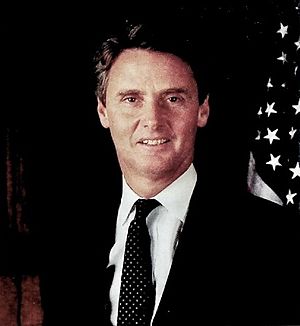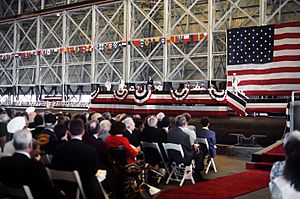Gaston Caperton facts for kids
Quick facts for kids
Gaston Caperton
|
|
|---|---|
 |
|
| 31st Governor of West Virginia | |
| In office January 16, 1989 – January 13, 1997 |
|
| Preceded by | Arch A. Moore Jr. |
| Succeeded by | Cecil H. Underwood |
| Personal details | |
| Born |
William Gaston Caperton III
February 21, 1940 Charleston, West Virginia, U.S. |
| Political party | Democratic |
| Spouses |
Dee Kessel
(m. 1965; div. 1989)Rachael Worby
(m. 1990; div. 1998)Idit Harel
(m. 2003; div. 2012) |
| Education | University of North Carolina at Chapel Hill (BA) |
William Gaston Caperton III (born February 21, 1940) is an American politician. He served as the 31st governor of West Virginia from 1989 to 1997. After his time as governor, he became the president of the College Board. This organization is known for the SAT and AP tests. He is a member of the Democratic Party.
Contents
Early Life and Career
Gaston Caperton was born in Charleston, West Virginia. He went to schools in Massachusetts and Virginia. Later, he studied at the University of North Carolina at Chapel Hill.
After college, he returned to Charleston. He took over his family's insurance business. Under his leadership, it grew into one of the largest privately owned insurance companies in the country. He also owned a bank. Caperton was first elected governor in 1988. This was his first time running for public office.
Governor of West Virginia (1988–1997)
Winning Elections
In the 1988 election, many people thought Caperton would not win. However, he won his party's primary election. Then, he surprised everyone by defeating the current Republican governor, Arch A. Moore Jr..
He ran for re-election in 1992. He won the Democratic primary and then the general election. He defeated the Republican candidate, Cleve Benedict. Caperton could not run for a third term in 1996 because of state rules.
Improving State Finances
During his first term, Governor Caperton worked to improve West Virginia's finances. He supported new laws about ethics, road building, and education. He raised taxes to help the state pay off its large debts. This helped turn a $500 million debt into a $100 million surplus.
Because of these changes, Financial World magazine called West Virginia the most improved state. Some people criticized him for raising taxes. However, his supporters said it was necessary because of the state's financial problems.
Focus on Education
Governor Caperton always said that education was his top priority. He supported a big school-building program. This led to $800 million being invested in schools. It helped build 58 new schools and renovate 780 others. This benefited many students across the state.
He also worked to raise teachers' salaries. West Virginia's teacher salaries moved up from 49th to 31st in the nation. He also helped train over 19,000 teachers. The goal was to help them use technology better in classrooms.
Caperton strongly encouraged using computers in schools. This led to the West Virginia Basic Skills Computer Program. It started with kindergarten and went through sixth grade. His idea was to have "computers in every classroom." In 1996, he received the Computerworld Smithsonian Award. This award recognized West Virginia's progress in education technology.
Boosting the Economy
As governor, Caperton also focused on growing the economy. He worked on modern roads, better infrastructure, and a clean environment. West Virginia's economy improved during his eight years in office. The number of people without jobs dropped from 9.8% to 6.2%. This was because about 86,000 new jobs were created.
He also started the West Virginia Streams Restoration Program. This program worked to clean up water pollution from coal mining.
National Leadership
Towards the end of his time as governor, Caperton took on national leadership roles. He chaired the Democratic Governors' Association in 1996. He also served on committees for the National Governors' Association. He received many awards and honorary degrees for his work.
Tamarack Arts Center
One important project from Caperton's time as governor is Tamarack, the Best of West Virginia. This facility is a museum, art gallery, and studios for artists. It shows off products made in West Virginia. Tamarack helps more than 1,200 West Virginia artists sell their work.
After Being Governor
Teaching and Education Leadership
After leaving office, Caperton taught at Harvard University. He also started an institute at Columbia University focused on education and government.
On July 1, 1999, Caperton became the President and CEO of the College Board. This is a non-profit group of schools and colleges. It is famous for the SAT college admissions test and the Advanced Placement (AP) Program. AP courses let high school students take college-level classes.
Under Caperton's leadership, the College Board worked to make AP courses available to more students. This included students in inner cities and rural areas. He was very concerned about unequal chances in education. He encouraged middle school students, especially those who were less fortunate, to go to college. USA Today called him an "education crusader."
Changes to the SAT Test
In 2004, Caperton led a successful effort to change the SAT test. The College Board added a writing test, more critical reading, and advanced math questions. The goal was to make the SAT better reflect what students learn in high school. The new SAT Reasoning Test was first given in March 2005.
Caperton also led a campaign called "Don't Forget Ed!" This aimed to make education a key topic in the 2012 presidential election.
In 2012, Caperton wrote a book called "The Achievable Dream: College Board Lessons on Creating Great Schools." This book shares ideas for creating successful schools.
Today, Caperton is the Vice Chairman for Leeds Equity Partners. This company focuses on education. He has been in this role since January 2013.
Personal Life
William Gaston Caperton III was born in Charleston, West Virginia. After college, he returned to Charleston to manage his family's insurance business.
Caperton has been married three times. He and his first wife, Ella Dee Caperton, had two sons, William Gaston IV and John. His second wife was Rachael Worby. His third wife was Idit Harel.



